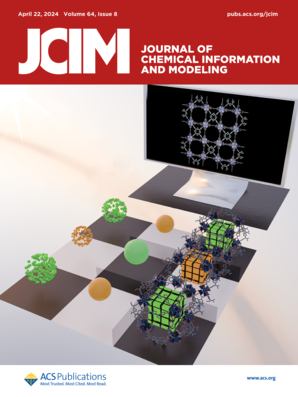De Novo Design of Cyclic Peptide Binders Based on Fragment Docking and Assembling.
IF 5.6
2区 化学
Q1 CHEMISTRY, MEDICINAL
引用次数: 0
Abstract
Cyclic peptides offer distinct advantages in modulating protein-protein interactions (PPIs), including enhanced target specificity, structural stability, reduced toxicity, and minimal immunogenicity. However, most cyclic peptide therapeutics currently in clinical development are derived from natural products or the cyclization of protein loops, with few methodologies available for de novo cyclic peptide design based on target protein structures. To fill this gap, we introduce CycDockAssem, an integrative computational platform that facilitates the systematic generation of head-to-tail cyclic peptides made entirely of natural - or -amino acid residues. The cyclic peptide binders are constructed from oligopeptide fragments containing 3-5 amino acids. A fragment library comprising 15 million fragments was created from the Protein Data Bank. The assembly workflow involves dividing the targeted protein surface into two docking boxes; the updated protein-protein docking program SDOCK2.0 is then utilized to identify the best binding fragments for these boxes. The fragments binding in different boxes are concatenated into a ring using two additional peptide fragments as linkers. A ROSETTA script is employed for sequence redesign, while molecular dynamics simulations and MM-PBSA calculations assess the conformational stability and binding free energy. To enhance docking performance, cation-π interactions, backbone hydrogen bonding potential, and explicit water exclusion energy were incorporated into the docking score function of SDOCK2.0, resulting in a significantly improved performance on the updated test set. A mirror design strategy was developed for cyclic peptides composed of -amino acids, where natural amino acid cyclic peptide binders are first designed for the mirror image of the target protein and the resulting complexes are then mirrored back. CycDockAssem was experimentally validated using tumor necrosis factor α (TNFα) as the target. Surface plasmon resonance experiments demonstrated that six of the seven designed cyclic peptides bind TNFα with micromolar affinity, two of which significantly inhibit TNFα downstream gene expression. Overall, CycDockAssem provides a robust strategy for targeted de novo cyclic peptide drug discovery.基于片段对接与组装的环状肽结合物从头设计。
环肽在调节蛋白-蛋白相互作用(PPIs)方面具有明显的优势,包括增强的靶点特异性、结构稳定性、降低的毒性和最小的免疫原性。然而,目前临床开发的大多数环肽疗法都来源于天然产物或蛋白质环的环化,很少有方法可以基于靶蛋白结构重新设计环肽。为了填补这一空白,我们引入了CycDockAssem,这是一个综合计算平台,可以系统地生成完全由天然-或-氨基酸残基制成的从头到尾环肽。环肽结合物由含有3-5个氨基酸的寡肽片段构成。从蛋白质数据库中创建了一个包含1500万个片段的片段库。装配流程包括将目标蛋白表面划分为两个对接盒;然后利用更新后的蛋白质-蛋白质对接程序SDOCK2.0来识别这些盒子的最佳结合片段。结合在不同盒子中的片段使用两个额外的肽片段作为连接物连接成一个环。采用ROSETTA脚本进行序列重新设计,同时进行分子动力学模拟和MM-PBSA计算,评估构象稳定性和结合自由能。为了提高对接性能,SDOCK2.0的对接评分函数中加入了阳离子-π相互作用、主氢键势和显水排斥能,在更新后的测试集上显著提高了对接性能。为-氨基酸组成的环肽开发了镜像设计策略,其中天然氨基酸环肽结合物首先被设计为靶蛋白的镜像,然后得到的复合物被镜像回来。CycDockAssem以肿瘤坏死因子α (TNFα)为靶点进行了实验验证。表面等离子体共振实验表明,设计的7种环肽中有6种与TNFα具有微摩尔亲和力,其中2种显著抑制TNFα下游基因的表达。总的来说,CycDockAssem为靶向新生环肽药物发现提供了一个强大的策略。
本文章由计算机程序翻译,如有差异,请以英文原文为准。
求助全文
约1分钟内获得全文
求助全文
来源期刊
CiteScore
9.80
自引率
10.70%
发文量
529
审稿时长
1.4 months
期刊介绍:
The Journal of Chemical Information and Modeling publishes papers reporting new methodology and/or important applications in the fields of chemical informatics and molecular modeling. Specific topics include the representation and computer-based searching of chemical databases, molecular modeling, computer-aided molecular design of new materials, catalysts, or ligands, development of new computational methods or efficient algorithms for chemical software, and biopharmaceutical chemistry including analyses of biological activity and other issues related to drug discovery.
Astute chemists, computer scientists, and information specialists look to this monthly’s insightful research studies, programming innovations, and software reviews to keep current with advances in this integral, multidisciplinary field.
As a subscriber you’ll stay abreast of database search systems, use of graph theory in chemical problems, substructure search systems, pattern recognition and clustering, analysis of chemical and physical data, molecular modeling, graphics and natural language interfaces, bibliometric and citation analysis, and synthesis design and reactions databases.

 求助内容:
求助内容: 应助结果提醒方式:
应助结果提醒方式:


